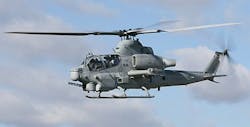Lockheed Martin chalks up another order for Marine attack helicopter electro-optical avionics
CRANE, Ind., 18 Dec. 2013. Electro-optical sensor experts at the Lockheed Martin Missiles and Fire Control segment in Orlando, Fla., have won another contract to provide a multi-sensor electro-optical/infrared (EO/IR) fire-control system for the U.S. Marine Corps Bell Cobra attack helicopter avionics.
Officials of the Naval Surface Warfare Center in Crane, Ind., announced a $34 million contract to Lockheed Martin (NYSE:LMT) late Tuesday to build AN/AAQ-30(A) Target Sight Systems (TSS) for the Marine Corps AH-1Z Cobra attack helicopter as part of the Marine Corps H-1 upgrades program.
The H-1 program is remanufacturing legacy Marine Corps AH-1 attack helicopters and UH-1 utility helicopter with state-of-the-art avionics and other subsystems. The program is converting the Marine Corps fleet of AH-1W attack helicopters into AH-1Zs. Lockheed Martin won a separate $34 million contract last August to provide TSS avionics for the AH-1Z helicopter.
The AN/AAQ-30 TSS comprises a large-aperture midwave infrared sensor, color TV camera, laser designator and rangefinder with eyesafe mode, and on-gimbal inertial measurement unit integrated into a stabilized turret.
The turret mounts to the nose of the aircraft via the Lockheed Martin-developed aircraft interface structure. TSS provides the capability to identify and laser-designate targets at maximum weapon range.
The TSS provides target identification and tracking, passive targeting for integrated weapons such as Hellfire missiles, and a laser designation capability supporting U.S. and allied laser-guided weapons.
Features of the TSS include an 8.55-inch aperture, midwave staring FLIR with four fields-of-view, multi-mode and multi-target tracker with coast-through-obscuration capability; gimbal stabilized to less than 15 microradians; on-gimbal inertial measurement unit for reduced image blur due to jitter; multi-mode multi-target tracker; image processing; high-magnification continuous-zoom color TV camera with field-of-view matched to the FLIR; and cooled 640-by-512-pixel indium antimonide detector.
On this contract Lockheed Martin will do the work in Orlando and Ocala, Fla., and should be finished by May 2016. For more information contact Lockheed Martin Missiles and Fire Control online at www.lockheedmartin.com/us/mfc, or the Naval Surface Warfare Center Crane at www.navsea.navy.mil/nswc/crane.

